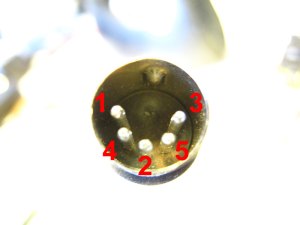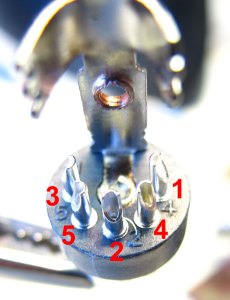A short article to help identify MIDI pin numbers in all those circuit drawings and photos on the internet.
The cables and connectors for standard (non-USB) MIDI connections
MIDI connections generally use 5 pin DIN connectors. Two pins carry the MIDI signal; pin 4 is set at 5 Volts and pin 5 is the actual signal pin (set at 5 Volts but goes to zero when a bit is transmitted).
MIDI is generally transmitted using 2 conductor cable. There is a shield and a twisted pair of signal conducting wires (twisted pair reduces external interference). Conforming to MIDI specs, the shield is connected to pin 2 at both ends. I use the CANARE L-2T2S cable to make my own cables if I have to. If you build your own cables, or just use store-bought cables, always test them: continuity is important, but a short can ruin your day! So, test pin to pin continuity (like pin 4 to pin 4 at each end of the cable), but also make sure that no pin is shorted to any other pin (like Pin 4 to Pin 5). In particular, make sure that Pin 2 is not connected to the DIN plug shield (the hard metal part surrounding the pins in the cable connector, also called plug shells). Some manufacturers don’t test this. Yes, I repeat, pin 2 must use the CABLE shield and not the PLUG shield, and pin 2 must be connected at both ends. This article has some more details. The cable is symmetrical.

On a MIDI OUT circuit, Pin 2 is connected to ground as is the female connector shield. Pin 2 must be left NOT CONNECTED in the MIDI IN circuit’s female connector, but the female connector shield IS connected to ground as per the official MIDI specifications. Many circuits leave the female receptacle shield not connected.
Used in this manner, with a standard MIDI cable, the fact that the ground (cable shield) is connected at one end only (MIDI OUT), the cable shield acts as an interference protector. It is important to understand that the MIDI ground (Pin 2) cannot be connected at both ends to prevent ground loops. These might cause hum when equipment share a ground through a signal cable but have separate chassis ground (through their power supply, for example).
Why use 5 pins? Apparently, the designers of MIDI reserved the extra pins for future use, as the MIDI protocol was expected to evolve. They are still unused after more than 30 years (MIDI protocol was invented in the early 1980’s). Why keep the 5 pin connectors? Because they are used on millions of instruments, synthesizers, control and pedal boards, interfaces and computers around the world.

Identifying the pins!
There is often confusion about MIDI pin numbering, so I’m adding a few pictures to help sort things out. RULE OF THUMB: There is a key, or notch on DIN round connectors. Note its position; top or bottom. Pin 2 is ALWAYS directly across from the notch. Pin numbers are NOT CONSECUTIVE. On a MALE connector, only used on MIDI cables, when looking at the pins, pin numbering is COUNTERCLOCKWISE and the first pin is 1. So if the first pin is 1, the only way to apply these 3 rules gives the sequence 1-4-2-5-3. on a FEMALE connector, pin numbering is CLOCKWISE and the first pin is, again, 1.
MIDI circuits on the internet show connectors from the front or the back. To remember if the circuit is showing the connector’s back or front, I use this simple mnemonic: The Face of the Female connector is numbered Clockwise (FFC or, simply, FaCe)
Here’s a few pictures showing pin numbers, front and back:



A special case: 7 pin connectors!
The 7 pin connectors are a little special. The first pin is 6. If you remember that, it is still the same general numbering rules.

Examples:
Official midi.org electrical specification circuit drawing:
In the circuit above, the female connectors (this is not a cable) are seen from the back since the numbers are counterclockwise.
In the next circuit, are we looking at the front or back of the connectors?
Answer: The notch is always across from pin 2. Since this is a circuit, and not a cable, these are female connectors. They are always numbered clockwise from the notch on the FaCe. So we are looking at the face, or front of the MIDI connectors. Note that the bottom connector is showed with the notch at the bottom. But this is still showing the face since the numbers are clockwise. Of course, this circuit is using 7 pin connectors so the first number is 6…
Finally, another circuit, with no indication of pin number. Can you tell which is which?
If you look at the image above from midi.org, showing the official MIDI electrical specifications, you can deduct that this is a MIDI IN circuit because it has a 4N28 optocoupler. From the Midi specs, you see that pin 4 is always connected to a 220 Ohm resistor and supplies the 5 Volts to the circuit. Pin 5 always carry the signal and is connected directly to the circuit. Since this is a circuit, not a cable, the connectors are female. Pin 4 is on the right and pin 5 is on the left so this is a counterclockwise pin order. Hence, this is the back of a female connector.



Leave a Reply